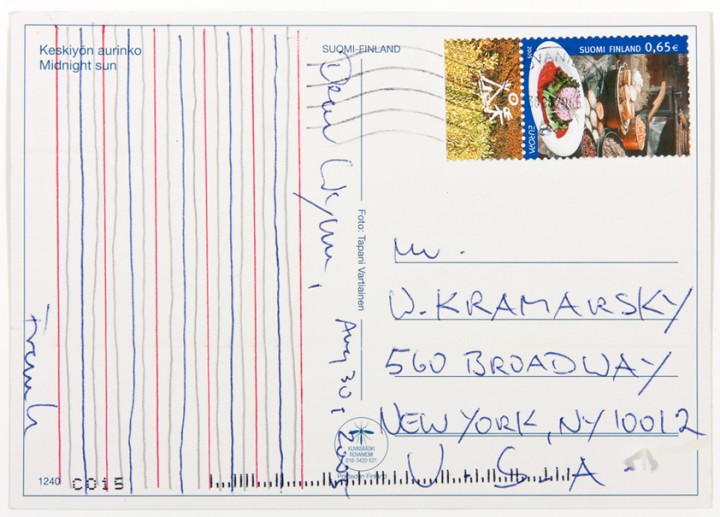
Music by Frank Badur; programming by Mark Badur.
My drawings start where the spoken word fails and where language breaks down in the attempt to formulate and express my specific perceptions and sensibilities.1
A postcard from an artist, sent in the mail, arrives at the office of a friend. Instead of writing a message, the artist – being an artist – has composed a drawing. This drawing is a series of lines in a pattern. Start with a red line drawn with a ruler. Follow with a freehand line drawn with a pencil. Then another freehand line, this time drawn in blue. Next, another freehand line drawn in pencil. Conclude as started, with a red line made with a ruler. Repeat four times. At the top of the drawing, the artist writes the date, Aug 30, 2005, and the salutation, Dear Wynn. Below the drawn lines, the artist closes with his name, Frank. This small, playful postcard drawing is balanced and symmetrical in its control and repetition.
If viewed closely, Frank Badur’s Untitled is reminiscent of a blank sheet of music. Badur has cited the sound patterns of composer Morton Feldman as a principal catalyst for his drawing process.2 In Matthias Bleyl’s essay, “Frank Badur’s Grid Drawings,” the writer explores Badur’s reference to Feldman’s musical principals: “Terms common to the visual arts such as suspension, proportion, series, structure, and pattern, as well as the issue of symmetry and asymmetry are characteristic of Feldman’s compositions.”3 It is apparent that most of these terms apply to elements of this drawing, a visual reaction to a musical inspiration.
Badur takes his work a step further by focusing on the most fundamental element of drawing – the line. He stated, “The line I draw is a concrete line that defines a concrete space. This line is a fact that represents nothing beyond itself.”4 Evident here is the control Badur has over his freehand lines, made with pencil and blue pen and confined to the space between the two red ruler-drawn lines. No line touches another. Noticeable is the sense of movement the freehand lines lend to the drawing, conceivably linking it to the aforementioned musical influence.
It makes perfect sense for an artist to send a collector a drawing in the body of a postcard, in lieu of a written message. There is no meaning to the lines. They only define the physical space in which they were drawn. The viewer is invited to take a closer look and to determine his or her own interpretation.
1. Frank Badur, “When I Draw in Black I Think in White” (lecture, Georgia State University, Atlanta, GA, 19 March 2007).
2. Ibid.
3. Matthias Bleyl, “Frank Badur’s Grid Drawings,” in Frank Badur Grid Drawings (Stuttgart: Galerie Michael Sturm, 2004), 7.
4. Badur, “When I Draw…”
Frank Badur Biography
Kathleen McEvily Biography
Pingback: Sarah JM Kolberg on Bruce Conner